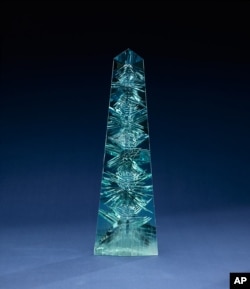WASHINGTON —
The Hope Diamond has long been the undisputed star of the Smithsonian National Museum of Natural History, but it's being upstaged by a new gem.
Visitors vied with media to capture the historic moment as museum director Kirk Johnson unveiled the latest addition to its mineral collection, the Dom Pedro Aquamarine.
“It’s 10,363 carats, which is what they call bling, serious bling,” Johnson said.
The blue-green crystal, a relative of the emerald, is carved into an obelisk that stands more than 35 centimeters high and weighs 2 kilograms. It is the largest cut and polished gem aquamarine in the world, says Jeffrey Post, curator of the museum’s mineral collection.
“It is very rare, very unusual for any mineral to produce a crystal the size and the quality that can result in cutting the Dom Pedro.”
And most would be cut into wearable gems, like the popular Hope Diamond.
But German gem artist Bernd Munsteiner, who carved the obelisk, told Post he didn’t want to do that.
“I said, 'Why did you cut something big, why not just cut it into gemstones?'” Post recalls his answer was, “‘What nature makes large, man should not make small.’”
Munsteiner created the Dom Pedro from a crystal that weighed 27 kilograms. He used a technique that he pioneered, called the fantasy cut. Channels are carved into the stone, instead of the usual facets on the outside. The result is a gem that appears to glow from within.
“And that gem traveled around,” Post says. “In fact, it represented the German government for some period of time at gem shows in Europe. And then, one of the owners was considering having it cut up to get his money out of it right away.”
“When I heard it was going to be cut up for jewelry stones, I thought that would be such a loss,” says American gem collector Jane Mitchell.
She and her husband, Jeffrey Bland, stepped forward and purchased the stone. “We had no desire to hold on to it privately. We felt it should strike awe in as many people as could be.”
That’s why they donated the Dom Pedro to the Smithsonian National Museum of Natural History. With 7.4 million visitors last year, it is the most popular museum in the United States, due - in large part - to the Hope Diamond.
Now visitors have another breathtaking reason to come here.
Visitors vied with media to capture the historic moment as museum director Kirk Johnson unveiled the latest addition to its mineral collection, the Dom Pedro Aquamarine.
“It’s 10,363 carats, which is what they call bling, serious bling,” Johnson said.
The blue-green crystal, a relative of the emerald, is carved into an obelisk that stands more than 35 centimeters high and weighs 2 kilograms. It is the largest cut and polished gem aquamarine in the world, says Jeffrey Post, curator of the museum’s mineral collection.
“It is very rare, very unusual for any mineral to produce a crystal the size and the quality that can result in cutting the Dom Pedro.”
And most would be cut into wearable gems, like the popular Hope Diamond.
But German gem artist Bernd Munsteiner, who carved the obelisk, told Post he didn’t want to do that.
“I said, 'Why did you cut something big, why not just cut it into gemstones?'” Post recalls his answer was, “‘What nature makes large, man should not make small.’”
Munsteiner created the Dom Pedro from a crystal that weighed 27 kilograms. He used a technique that he pioneered, called the fantasy cut. Channels are carved into the stone, instead of the usual facets on the outside. The result is a gem that appears to glow from within.
“And that gem traveled around,” Post says. “In fact, it represented the German government for some period of time at gem shows in Europe. And then, one of the owners was considering having it cut up to get his money out of it right away.”
“When I heard it was going to be cut up for jewelry stones, I thought that would be such a loss,” says American gem collector Jane Mitchell.
She and her husband, Jeffrey Bland, stepped forward and purchased the stone. “We had no desire to hold on to it privately. We felt it should strike awe in as many people as could be.”
That’s why they donated the Dom Pedro to the Smithsonian National Museum of Natural History. With 7.4 million visitors last year, it is the most popular museum in the United States, due - in large part - to the Hope Diamond.
Now visitors have another breathtaking reason to come here.






